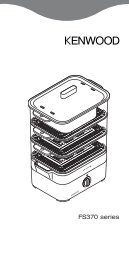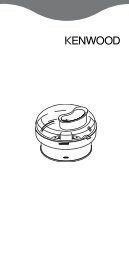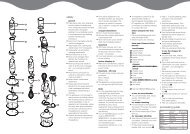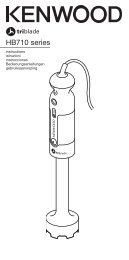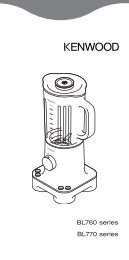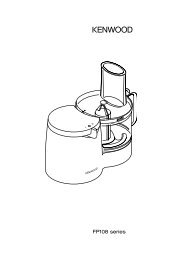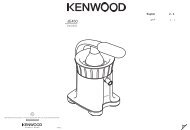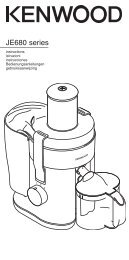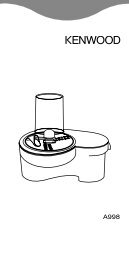Untitled - Kenwood
Untitled - Kenwood
Untitled - Kenwood
You also want an ePaper? Increase the reach of your titles
YUMPU automatically turns print PDFs into web optimized ePapers that Google loves.
ingredients<br />
The major ingredient in bread making is flour, so selecting<br />
the right one is the key to a successful loaf.<br />
wheat flours<br />
Wheat flours make the best loaves. Wheat consists of an<br />
outer husk, often referred to as bran, and an inner kernel,<br />
which contains the wheat germ and endosperm. It is the<br />
protein within the endosperm which, when mixed with<br />
water, forms gluten. Gluten stretches like elastic and the<br />
gases given off by the yeast during fermentation are<br />
trapped, making the dough rise.<br />
white flours<br />
These flours have the outer bran and wheat germ<br />
removed, leaving the endosperm which is milled into a<br />
white flour. It is essential to use strong white flour or white<br />
bread flour, because this has a higher protein level,<br />
necessary for gluten development. Do not use plain white<br />
flour or self-raising flour for making yeast risen breads in<br />
your bread maker, as inferior loaves will be produced.<br />
There are several brands of white bread flour available,<br />
use a good quality one, preferably unbleached, for the<br />
best results.<br />
wholemeal flours<br />
Wholemeal flours include the bran and wheat germ, which<br />
gives the flour a nutty flavour and produces a coarser<br />
textured bread. Again strong wholemeal or wholemeal<br />
bread flour must be used. Loaves made with 100%<br />
wholemeal flour will be more dense than white loaves. The<br />
bran present in the flour inhibits the release of gluten, so<br />
wholemeal doughs rise more slowly. Use the special<br />
wholewheat programs to allow time for the bread to rise.<br />
For a lighter loaf, replace part of the wholemeal flour with<br />
white bread flour.<br />
strong brown flour<br />
This can be used in combination with white flour, or on its<br />
own. It contains about 80-90% of the wheat kernel and<br />
so it produces a lighter loaf, which is still full of flavour. Try<br />
using this flour on the basic white cycle, replacing 50% of<br />
the strong white flour with strong brown flour. You may<br />
need to add a little extra liquid.<br />
19<br />
granary bread flour<br />
A combination of white, wholemeal and rye flours mixed<br />
with malted whole wheat grains, which adds both texture<br />
and flavour. Use on its own or in combination with strong<br />
white flour.<br />
non-wheat flours<br />
Other flours such as rye can be used with white and<br />
wholemeal bread flours to make traditional breads like<br />
pumpernickel or rye bread. Adding even a small amount<br />
adds a distinctive tang. Do not use on its own, as it will<br />
produce a sticky dough, which will produce a dense<br />
heavy loaf. Other grains such as millet, barley, buckwheat,<br />
cornmeal and oatmeal are low in protein and therefore do<br />
not develop sufficient gluten to produce a traditional loaf.<br />
These flours can be used successfully in small quantities.<br />
Try replacing 10-20% of white bread flour with any of<br />
these alternatives.<br />
salt<br />
A small quantity of salt is essential in bread making for<br />
dough development and flavour. Use fine table salt or sea<br />
salt, not coarsely ground salt which is best kept for<br />
sprinkling on top of hand-shaped rolls, to give a crunchy<br />
texture. Low-salt substitutes are best avoided as most do<br />
not contain sodium.<br />
● Salt strengthens the gluten structure and makes the<br />
dough more elastic.<br />
● Salt inhibits yeast growth to prevent over-rising and<br />
stops the dough collapsing.<br />
● Too much salt will prevent the dough rising sufficiently.<br />
sweeteners<br />
Use white or brown sugars, honey, malt extract, golden<br />
syrup, maple syrup, molasses or treacle.<br />
● Sugar and liquid sweeteners contribute to the colour of<br />
bread, helping to add a golden finish to the crust.<br />
● Sugar attracts moisture, so improving the keeping<br />
qualities.<br />
● Sugar provides food for the yeast, although not<br />
essential, as modern types of dried yeast are able to<br />
feed on the natural sugars and starches found in the<br />
flour, it will make the dough more active.<br />
● Sweet breads have a moderate level of sugar with the<br />
fruit, glaze or icing adding extra sweetness. Use the<br />
sweet bread cycle for these breads.<br />
● If substituting a liquid sweetener for sugar then the total<br />
liquid content of the recipe will need to be reduced<br />
slightly.



